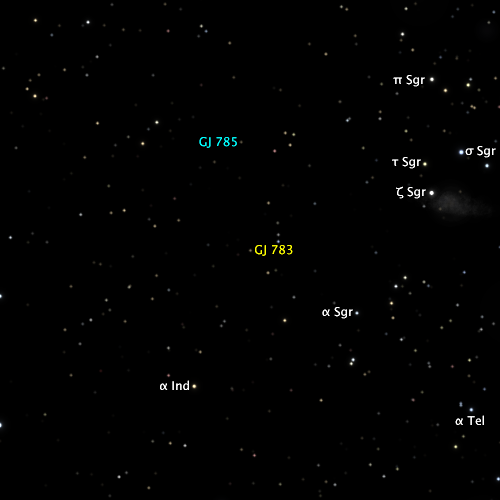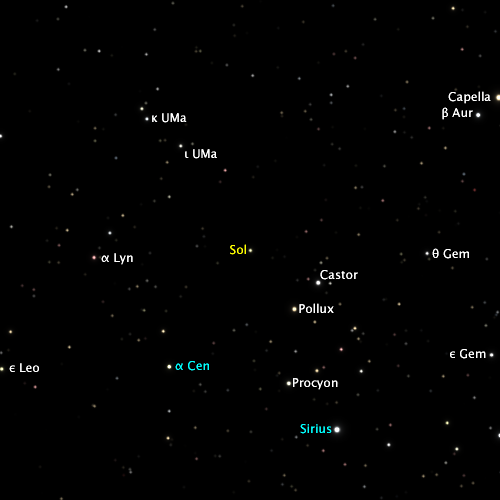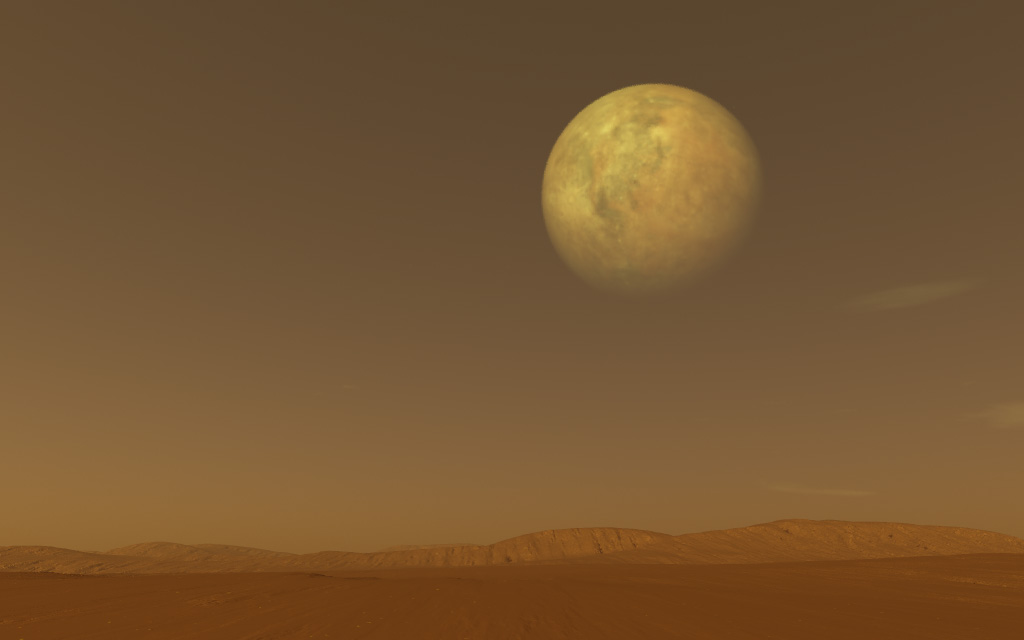as seen from Sol.
Gliese 783.


| Right Ascension | 20h 11m | |
|---|---|---|
| Declination | −36° 06' | |
| Distance | 19.73 ± 0.11 ly | |
| Star | Gliese 783 A | Gliese 783 B |
| Spectral Class | K2V | M3.5V |
| Estimated Mass | 0.82 × Sol | 0.20 × Sol |
| Luminosity | 0.310 × Sol | 0.00573 × Sol |
| Gliese 783 as seen from Sol. |
Sol as seen from Gliese 783. |
|---|---|
 |
 |
| Star | Magnitude | Distance |
|---|---|---|
| Canopus | −0.62 | 309.2 |
| Fomalhaut | −0.02 | 14.5 |
| Rigel | 0.21 | 872.7 |
| Achernar | 0.29 | 129.5 |
| Vega | 0.31 | 28.5 |
| Arcturus | 0.38 | 44.7 |
| Altair | 0.43 | 14.3 |
| Betelgeuse | 0.51 | 512.7 |
| Beta Centauri (Hadar) | 0.56 | 382.6 |
| Alpha Crucis (Acrux) | 0.73 | 315.3 |
| Alpha Aurigae (Capella) | 0.82 | 60.2 |
| Sirius | 0.93 | 25.5 |
| Spica | 1.00 | 251.4 |
Gliese 783 is a binary star system located about 19.73 light years from Sol. The star system is an old system, estimated to be about 10 billion years old.
Gliese 783 A and Gliese 783 B orbit each other in a wide orbit.
| Destination | Distance |
|---|---|
| 41 Arae | 16.4 |
| Gliese 785 | 10.1 |
| Gliese 832 | 7.1 |
| Planet | SMA (AU) |
Orbital Period |
e | Equatorial Diameter (km) |
Mass (Earths) |
Density (g/cm3) |
Gravity (Earth g) |
Atmospheric Pressure (Earth=1) |
Sidereal Day |
Mean Solar Day |
Axial Tilt |
Known Moons |
|---|---|---|---|---|---|---|---|---|---|---|---|---|
| Hothouse | 0.2694 | 56.403 d | 0.0661 | 11190 | 0.5983 | 4.87 | 0.7773 | 114 | 56d 09h 40.0m | Synchronous | 00° 28.1' | 0 |
| Boulder | 0.4468 | 120.46 d | 0.0144 | 4693 | 0.03743 | 4.13 | 0.2764 | 0.000150 | 120d 11h 06.5m | Synchronous | 00° 41.2' | 0 |
| Binaria Major | 0.7577 | 266.03 d | 0.0377 | 8948 | 0.2895 | 4.62 | 0.5880 | 0.486 | 1d 04h 21.8m | 1d 04h 29.4m | 33° 00.3' | 0 |
| Binaria Minor | 5914 | 0.06782 | 3.75 | 0.3153 | 0.225 | 1d 04h 21.8m | 1d 04h 29.4m | 33° 05.6' | ||||
| Chill | 1.162 | 1.3835 y | 0.0214 | 5579 | 0.05907 | 3.89 | 0.3086 | 0.194 | 1d 04h 22.3m | 1d 04h 26.2m | 27° 24.3' | 1 |
| Iceberg | 2.064 | 3.2736 y | 0.0126 | 17730 | 1.476 | 3.02 | 0.7633 | 8.59 | 3d 16h 39.6m R | 3d 16h 23.2m | 101° 43.3' | 3 |
| Tania | 7.489 | 22.631 y | 0.0095 | 91060 | 60.64 | 0.945 | 1.189 | &mdash | 15h 39.9m | 15h 40.0m | 11° 56.1' | 13 |
| Name | Diameter (km) |
Period (days) |
Semimajor Axis (km) |
Ecc | Inc |
|---|---|---|---|---|---|
| Natural Satellites of Chill | |||||
| Chill I | 226 | 8.165 | 66710 | 0.0265 | 0.22 |
| Natural Satellites of Iceberg | |||||
| Iceberg I | 3883 | 11.38 | 243400 | 0.0067 | 0.25 |
| Iceberg II | 16 | 11.38 | 243400 | 0.0304 | 1.55 |
| Iceberg III | 53 | 32.27 | 487400 | 0.0812 | 11.21 |
| Natural Satellites of Tania | |||||
| Tania IX | 35 | 0.7801 | 140600 | 0.0003 | 0.02 |
| Tania X | 43 | 0.9106 | 155900 | 0.0050 | 0.20 |
| Tania IV | 754 | 1.214 | 188800 | 0.0064 | 0.25 |
| Tania I | 3696 | 2.425 | 299600 | 0.0262 | 2.49 |
| Tania II | 5765 | 4.843 | 475000 | 0.0037 | 0.49 |
| Tania XI | 33 | 4.843 | 475000 | 0.0147 | 2.08 |
| Tania III | 3484 | 9.700 | 754900 | 0.0135 | 3.16 |
| Tania V | 1155 | 22.50 | 1323000 | 0.0297 | 2.95 |
| Tania VII | 171 | 41.68 | 1995000 | 0.0288 | 0.77 |
| Tania XII | 86 | 67.98 | 2764000 | 0.0682 | 4.80 |
| Tania VI | 203 | 196.1 | 5602000 | 0.1549 | 9.25 |
| Tania VIII | 165 | 280.8 | 7117000 | 0.1381 | 16.02 |
| Tania XIII | 153 | 343.2 | 8135000 | 0.4381 | 28.48 |
As its name suggests, Hothouse is a typical Cytherean world, with an atmosphere even denser than that of Venus. The world is tidally locked to its sun, with eternal day and night on the two hemispheres. Despite the tidal locking, the surface temperature is much the same all over the planet. The strong winds in the hot, crushing atmosphere effectively transfers the heat of the local sun all over the planet. The surface temperature of Hothouse is nearly 100 K hotter than Venus because it is closer to its sun and its atmosphere reflects less light.
Boulder is a small world with a relatively large metal core. Its core size and density are intermediate between a Hermian world (large core) and a Selenian world (small core), and it has characteristics of both classes of world. The world has a trace of atmosphere.

|
Binaria is a double planet comprising a pair of Arean (Marslike) worlds that are tidelocked to each other. Binaria Major is the larger world, and Binaria Minor is the smaller. Both worlds have appreciable atmospheres dominated by carbon dioxide, nitrogen and argon.
Binaria Major has small quantities of ice in polar ice caps, and additional ice in the permafrost. The world is one of several worlds outside the solar system on which life is believed to exist but no evidence for life has yet been found to prove this theory. The world is on a shortlist for future terraforming.
Binaria Minor is the largest moon in this system, and is the only moon in this system with a formal name.
Binaria Major is home to the hidden renegade colony of Nathaniel.
Chill is an Arean world with an atmosphere about one-fifth as dense as Earth’s. The world is very cold despite being about as far from its sun as Earth is from Sol. This coldness is due to the local sun being substantially dimmer than Sol.
Iceberg is a large Titanian world with a thick methane atmosphere. The world has a large moon and an extreme axial tilt.
Tania is a EuJovian world with a prominent equatorial band and the usual system of moons. Its tan colour gives the world its name.
| Planet | SMA (AU) |
Orbital Period |
e | Equatorial Diameter (km) |
Mass (Earths) |
Density (g/cm3) |
Gravity (Earth g) |
Atmospheric Pressure (Earth=1) |
Sidereal Day |
Mean Solar Day |
Axial Tilt |
Known Moons |
|---|---|---|---|---|---|---|---|---|---|---|---|---|
| Bask | 0.2252 | 85.199 d | 0.0027 | 7916 | 0.2295 | 5.28 | 0.5956 | &mdash | 85d 04h 46.3m | Synchronous | 00° 02.3' | 0 |
| Dustin | 0.3696 | 179.06 d | 0.0044 | 8236 | 0.2331 | 4.76 | 0.5588 | &mdash | 179d 01h 29.8m | Synchronous | 00° 19.1' | 0 |
| Russet | 0.6583 | 1.1655 y | 0.0200 | 5319 | 0.05725 | 4.36 | 0.3291 | &mdash | 09h 24.3m | 09h 24.8m | 13° 17.6' | 0 |
| Desolation | 1.301 | 3.2396 y | 0.0256 | 6763 | 0.1071 | 3.97 | 0.3806 | &mdash | 14h 04.1m | 14h 04.5m | 28° 16.2' | 2 |
| Turquoise | 4.164 | 18.544 y | 0.0446 | 63050 | 33.78 | 1.58 | 1.382 | &mdash | 16h 21.8m | 16h 21.9m | 16° 13.2' | 8 |
| El Blando | 6.506 | 36.211 y | 0.0126 | 48060 | 12.82 | 1.33 | 0.9029 | &mdash | 1d 02h 13.4m | 1d 02h 13.5m | 16° 49.8' | 6 |
| Name | Diameter (km) |
Period (days) |
Semimajor Axis (km) |
Ecc | Inc |
|---|---|---|---|---|---|
| Natural Satellites of Desolation | |||||
| Desolation I | 84 | 2.099 | 32880 | 0.0085 | 0.10 |
| Desolation II | 855 | 13.22 | 112100 | 0.0044 | 0.12 |
| Natural Satellites of Turquoise | |||||
| Turquoise I | 287 | 0.7435 | 112100 | 0.0012 | 0.24 |
| Turquoise II | 569 | 0.8770 | 125100 | 0.0009 | 1.70 |
| Turquoise III | 1110 | 1.432 | 173500 | 0.0053 | 0.37 |
| Turquoise IV | 1226 | 2.455 | 248500 | 0.0033 | 0.96 |
| Turquoise V | 615 | 4.563 | 375700 | 0.0055 | 1.80 |
| Turquoise VI | 734 | 9.127 | 596400 | 0.0934 | 144.96 |
| Turquoise VII | 170 | 46.25 | 1759000 | 0.2580 | 163.01 |
| Turquoise VIII | 140 | 119.5 | 3313000 | 0.1020 | 12.20 |
| Natural Satellites of El Blando | |||||
| El Blando I | 414 | 1.147 | 181900 | 0.0076 | 0.05 |
| El Blando II | 1554 | 1.723 | 238500 | 0.0035 | 0.37 |
| El Blando III | 1085 | 3.448 | 378800 | 0.0277 | 0.40 |
| El Blando IV | 1006 | 6.883 | 600500 | 0.0125 | 2.30 |
| El Blando V | 603 | 10.35 | 788000 | 0.0147 | 4.42 |
| El Blando VI | 124 | 22.33 | 1316000 | 0.1403 | 2.08 |
El Blando’s whimsical name comes from its rather bland appearance. This CryoJovian world has few visible markings on its disk. Despite being only 6.5 AU from its sun, El Blando is the outermost planet in its system, due to the proximity of the brighter companion sun. El Blando has six known moons.
This page uses the planetary classification system developed for the ArcBuilder Universe by J.M.Dollan.